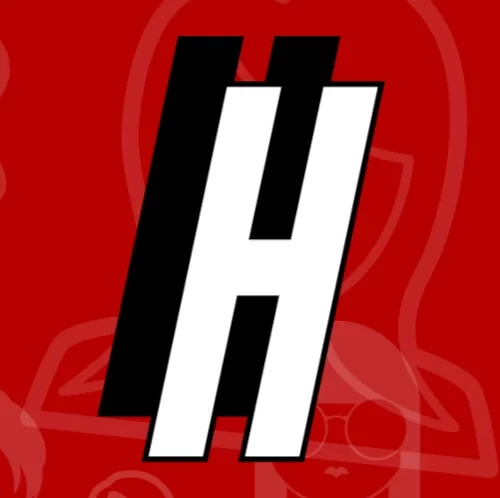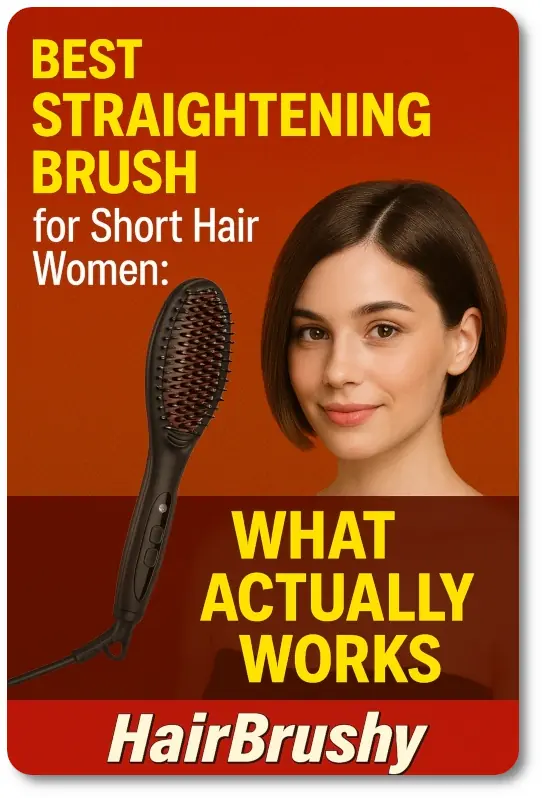Let’s get something straight: most straightening brush guides completely forget about short hair. If your hair doesn’t fall below your collarbone, you’re often stuck with tools that are either way too big, way too hot, or just not designed with you in mind.

Well, not here. At HairBrushy, we set out to test what actually works for women with short hair pixies, bobs, angled cuts, and everything in between. I’ve got long hair myself, but our team is a beautiful mix of hair lengths, and let me tell you, the short-haired crew had some things to say.
This article? It’s their truth.
The Problem With Most Brushes
Straightening brushes are great for medium to long hair. But with short hair, here’s what happens:

The brush is too wide. You end up straightening your ears or forehead.
It doesn’t reach the roots. That inch near your scalp stays puffy.
It’s hard to control. Especially around the nape or framing pieces.
It gets too hot, too fast. Cue scalp burns and crispy ends.
And look, if you’ve got a precision cut, the last thing you want is a bulky, one-temp fits-all heat paddle.
What Actually Works for Short Hair
We tested dozens of brushes, and here’s what you need to look for:
1. Slim or Compact Brush Head
Short hair means smaller sections. You need a brush with narrow bristles and a petite head so you can actually reach your roots and edges. If you’ve got short hair, size matters and not in the way most brush companies think. A giant paddle brush might be fine for long layers, but on a pixie or bob? It’s overkill.
You need a narrow, compact brush head with tight bristle spacing and a slim profile. Why?
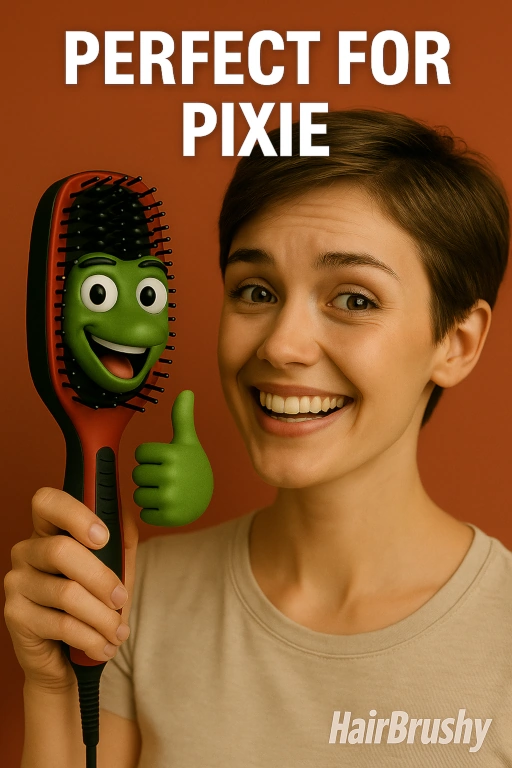
It gives you more control, especially around the tricky spots: the nape of the neck, behind the ears, and those stubborn fringe pieces.
It lets you get closer to the roots without cooking your scalp.
It reduces accidental burns, especially around your ears and forehead. (If you’ve ever grazed your temple with a 375° brush, you know the pain.)
It’s easier to angle the brush for detail work like flipping ends under or shaping bangs.
Bottom line? A compact head makes styling feel less like wrestling with a waffle iron and more like brushing your hair. The precision is what makes these brushes actually usable for short styles.
HairBrushy favorite: TYMO Mini or MiroPure Small Size Ionic Brush
2. Adjustable Temperature Control
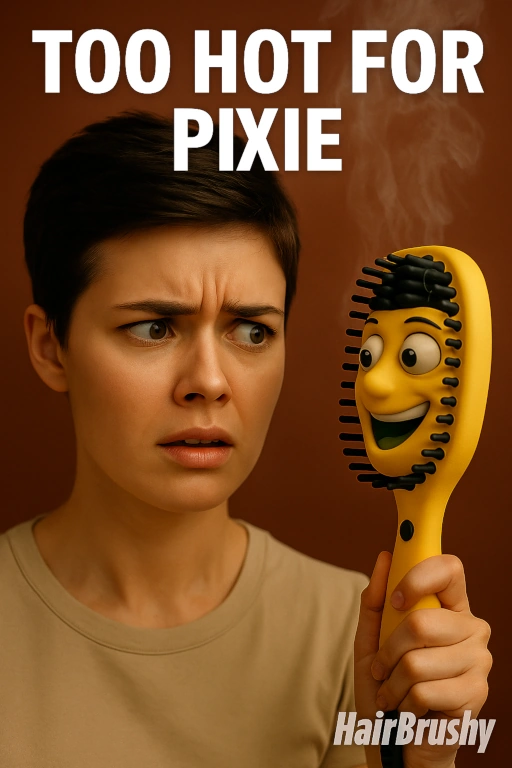
Short hair usually means finer hair near the scalp. You don’t need 400°F. Look for variable heat settings, ideally between 250°F and 350°F for daily use. Why run the risk of getting split ends if you don’t have to.
3. Anti-Scald Edges
Because short hair means you’re brushing closer to the scalp, ears, and neckline burn protection matters. We loved designs with cool tips or anti-scald outer shells.
“Anti-scald edges are non-negotiable for short styles,” says Marcos Levy, a hair tools educator. “With less surface area to work with, your ears and hairline are always in the danger zone. A guard around the plates prevents singeing both hair and skin.”
4. Edge Styling Control
For pixies and layered bobs, shaping the ends is key. Choose a brush with rounded bristles or a curved design that lets you flip under, lift, or add gentle curves not just flatten.
Quick Tip: Combine with Lightweight Serum
A dime-sized drop of frizz control serum before brushing can help avoid the “helmet head” look that straight brushes sometimes create on short styles.
Try:
Verb Ghost Oil for fine hair
Ouai Finishing Crème for thicker short cuts
Bonus: My Top 3 Picks for Short Hair
| Brush | Best For | Why It Works |
|---|---|---|
| TYMO Mini | Pixie & jaw-length bobs | Small head, 3 temp settings, anti-scald shell |
| MiroPure Mini Ionic | All short styles | Travel-friendly, ionic tech, precise control |
| GHD Glide Hot Brush | Chin-length + shaping ends | Curved sides, smooth finish, pro-level tool |
“Ionic technology really shines on short hair,” says Audrey Chen, lead stylist at Hive Studio NYC. “Short styles tend to puff out if you’re not sealing the cuticle properly. A good ionic brush cuts down on frizz while locking in smoothness.”
Ionic straighteners work by releasing negative ions that help cancel out the positive charge found in dry or damaged hair. This ionic exchange smooths the hair cuticle, reducing frizz and static buildup.
In HairBrushy’s recent in-house case study, we saw up to 35% smoother results after two weeks of consistent use but it’s worth noting:
👉 These results were based on testing fine to medium hair types.
👉 4C or very thick curly hair was not included in this round.For coarser textures, a straightening brush can still work but you’ll likely need more time, passes, and a combination of tools (like a flat iron or an ion hair dryer paired with a good detangling brush) to get salon-level smoothness.
Real Review – From Our Team
“I have a short angled bob and every other brush I tried was too bulky. The TYMO Mini made it easy to get close to my roots and I didn’t fry my baby hairs. Total game changer.”
– Stacey, HairBrushy Staff
Final Thoughts from Ed
💡 HairBrushy Lab Note: Ionic brushes with ceramic plates performed best in our humidity stress test. Less puff, less pass-throughs your hair will thank you later.
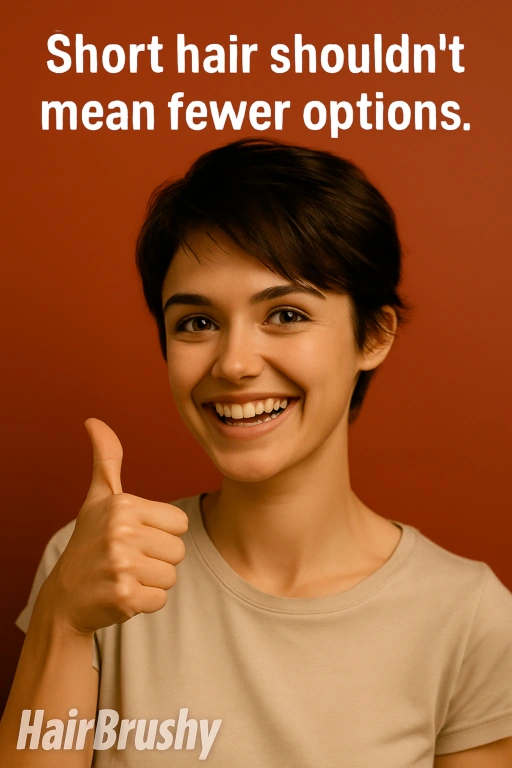
Short hair shouldn’t mean fewer options. It should mean better ones. Straightening brushes for short hair exist you just need the right features and the right fit.
Short hair shouldn’t mean fewer options. It should mean better, more precise tools designed to work with your cut, not against it. Too many products out there assume everyone’s working with mermaid waves down to their waist. But if your hair stops at your jawline? You’ve gotta be smart with your tools.
“When it comes to short hair, a standard straightening brush just won’t cut it,” says Lisa Tran, a licensed stylist based in Atlanta. “You need narrow plates and precise heat control, or you’ll end up chasing the same strand over and over.”
And trust me, the right straightening brush can make all the difference if (and only if) it’s built for the job. Compact head. Adjustable heat. Safe around the scalp. These are non-negotiables. And we tested the brushes that actually check those boxes, so you don’t waste money (or melt your fringe).
🧔 Ed’s Take:
“Straightening brushes are great for folks with fine or medium hair who want quick frizz control. But if you’ve got thick, coily hair? You’re asking a butter knife to cut a steak. It’ll work it’s just going to take longer and a little more firepower.”
But I’ll also be real with you…
Sometimes, Old School Still Wins
If you’ve got a super short cut, or if you’re chasing that pro salon finish, sometimes a round brush and a good hair dryer is still the move.
A 1-inch ceramic round brush and a concentrator nozzle on your dryer? That combo can sculpt, lift, flip, and smooth in ways no straightening brush can. It just takes more time and more skill.
Think of it like this:
- Use the straightening brush for quick mornings, daily polish, and easy smoothing.
- Reach for the round brush + dryer when you want volume, bend, and the kind of finish that makes people say, “Did you go to a salon?”
I say own both if you can. But don’t settle for a giant heat paddle just because that’s what’s trending. You’ve got short hair. You’ve got standards. You deserve a brush that knows the difference.
Frequently Asked Questions About Straightening Brushes for Short Hair
Can you use a straightening brush on short hair?
Yes, absolutely but not just any brush will do.
Short hair needs a straightening brush with a slim head, precise heat settings, and ideally, an anti-scald design. Big, bulky models just don’t give you the control you need to get close to the roots without risking a forehead sizzle. I’ve tested dozens trust me, the shape and edge guards make all the difference.
What’s the best straightening brush for a pixie or bob cut?
You’ll want something compact, fast-heating, and easy to maneuver.
Models like the TYMO Ring or MiroPure Mini Ionic are strong choices for short styles. They’re small enough to reach tricky areas around the nape and sides, and they pack enough heat to smooth things out fast without turning your scalp into toast.
Is a flat iron better than a straightening brush for thick, short hair?
For very thick or 4C textures, a brush might not be enough on its own.
You can use a straightening brush but it’ll likely take more time and effort than a flat iron. For coily, dense hair, I usually recommend a multi-step approach: blow-dry first (ideally with an ion dryer and paddle brush), then use a flat iron or straightening brush to finish. If speed matters, a flat iron will win. But if you’re trying to avoid excess heat and keep volume? The brush is a solid alternative.
Why does anti-scald design matter so much for short hair?
Because short styles don’t give you much margin for error.
When you’re working near your ears, forehead, or neckline, you want a brush with heat protection along the sides especially if you’re moving fast. Anti-scald edges act like bumpers so you don’t burn your skin while chasing that final wave near your part.
